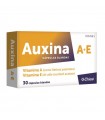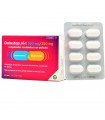Daflon is a venotonic medicine: it increases the tone of the veins and the resistance of the capillaries (small blood vessels). Daflon is indicated,in adults, for the relief ofsymptoms related to mild venous insufficiency of the lower extremities, such as pain, feeling heaviness, tightness, tingling and itching in legs with varicose veins or swollen legs. You should consult a doctor if it gets worse or does not improveafter2 weeks of treatment.
ACTION AND MECHANISM
Venotonic and vasoprotective. It produces venoconstriction, increased vessel resistance and decreased permeability.
In the animal, it exerts a double action on the venous return system:
- at the level of veins and veins: increases parietal tonicity and exerts an antistatic action;
- at the microcirculation level: normalizes Hair Care permeability and strengthens hair resistance.
In man, double-blind controlled studies have confirmed venotonic activity: the venous tone increases: venous occlusion pletismography with mercury ring has revealed a decrease in venous emptying times.
It has also shown activity on microcirculation: in patients who show signs of Hair Care fragility, it increases the Hair Care resistance measured by angioesterometry.
Elderly
There have been no significant differences in adverse effects between geriatric patients and younger patients in one study. Use accepted.
PATIENT ADVICE
- It is recommended to take the tablets after lunch and dinner.
- This medicine is intended for the short-term treatment of venous insufficiency, for periods less than 2-3 months.
Contraindications
- Hypersensitivity to diosmine or other flavonoids.
Pregnancy
No harmful effects are reported on the human species. Experimental studies have not revealed any teratogenic effects.
Caution should be exercised in prescribing pregnant women.
Pharmacokinetics
The pharmacokinetics of diosmine are linear.
Orally:
- Absorption: diosmine is rapidly transformed by intestinal flora and absorbed into its aglicone (diosmetine) form. Bioavailability: 57.9% approx.
- Distribution: extensive (You: 62.1 L).
- Metabolism: diosmetine is rapidly and widely degraded to phlebotonic acids or their glycine conjugated derivatives, which are removed in the urine. Predominant metabolite: hydroxyphenylpropionic acid (which is mostly conjugated). Metabolites in smaller amounts: other phenolic acids corresponding to 1-hydroxy-4-methoxybenzoic acid, 3-methoxy-4-hydroxyphenylactic acid and 3.4-dihydroxybenzoic acid.
- Elimination: relatively fast. In studies with radiolabeled diosmine, 34% of the dose was recovered in urine and faeces after the first 24 hours, and approximately 86% recovered in urine and faeces after the first 48 hours.
Indications
- Short-term relief (2 to 3 months) of edema and symptoms related to chronic [VENOSA INSUFFICIENCY].
Breast feeding
It is not known whether this medicinal product is excreted with human milk, however, minimal breast milk excretion (1) has been observed in a study in animal models. In the absence of conclusive data on the passage to breast milk, its use during lactation is not recommended.
Children
Not enough clinical experience is available in this age group. Use not recommended.
RULES FOR PROPER ADMINISTRATION
Take with meals (half day and dinner).
Dosage
- Adults: Usual therapeutic dose: 500 mg/12 h at no time and at night, with meals.
- Children and adolescents < 18 years: not recommended.
- Elderly: no dosing adjustment required.
Duration of treatment: 2-3 months maximum.
ADVERSE REACTIONS
Adverse effects of diosmine are generally uncommon, mild and transient.
Adverse reactions are described according to each frequency interval, considered very common (>10%), common (1-10%), uncommon (0.1-1%), rare (0.01-0.1%), very rare (<0.01%) or of unknown frequency (cannot be estimated from the available data).
-Digestive: common: [NAUSEAS], [VOMITOS], [DISPEPSIA], [DIARREA].
-Neurological/psychological: rare: [CEFALEA], discomfort, [VERTIGO].
-Allergic/dermatological: rare: [EXANTEMATIC ERUPTIONS], [PRURITO], [URTICARIA].
Overdose
No cases of overdose have been reported. The wide therapeutic scope of this specialty determines that the risk of poisoning is virtually zero.































